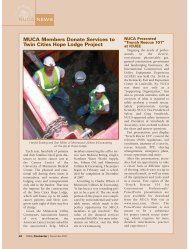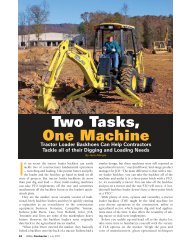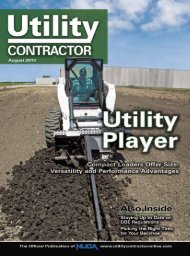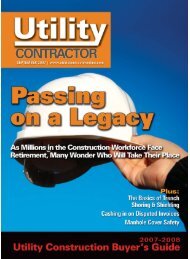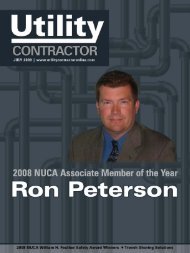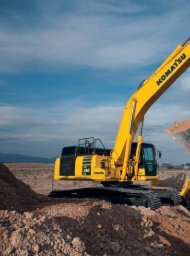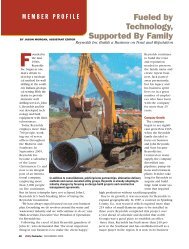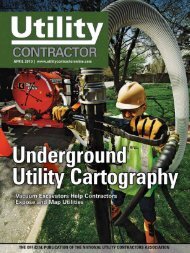View Full May PDF Issue - Utility Contractor Online
View Full May PDF Issue - Utility Contractor Online
View Full May PDF Issue - Utility Contractor Online
Create successful ePaper yourself
Turn your PDF publications into a flip-book with our unique Google optimized e-Paper software.
So for every diesel machine over 25-hp, a contractor must<br />
make a record of that machine and report it to CARB. CARB<br />
will then issue an equipment identification number for each<br />
vehicle, which must be used to label the vehicle within 30 days<br />
of receipt.<br />
When is this happening Right now. The deadline for large<br />
fleets in California was April 1, while medium and small fleets<br />
have until June 1, 2009, and August 1, 2009, respectively. For<br />
those readers in California, vehicles can be reported via CARB’s<br />
online reporting system, DOORS. The reporting system and<br />
user guides are available online at: secure.arb.ca.gov/ssldoors/<br />
doors_reporting/reporting.php.<br />
“Enforcement staff will then randomly inspect machines<br />
operating in the field to be sure that each machine meets the<br />
emissions-reduction actions documented in the annual reporting<br />
process,” explains Chruschiel.<br />
Californication<br />
If you’re saying to yourself, “That sounds like a lot of fiery<br />
hoops those laid back West-coasters have to jump through but<br />
that doesn’t affect me” — you’d be wrong, mister. Based on the<br />
current non-attainment areas, there are a total of 408 counties<br />
that must comply with PM2.5 and/or ozone regulations.<br />
Don’t know what a non-attainment area is It’s defined by the<br />
Clean Air Act and Amendments of 1990 as a locality where air<br />
pollution levels persistently exceed the National Ambient Air<br />
Quality Standards or that contribute to ambient air quality in<br />
a nearby area that fails to meet the standards. And the number<br />
of those areas is growing — a projected 440 to 550 counties in<br />
2010 and beyond, according to the EPA.<br />
If California is successful in reducing the state’s emission<br />
level, other states may fall into line by adopting similar legislation.<br />
This doesn’t mean that you have to run out and replace<br />
all your machines.<br />
“We know from our parts and remanufacturing businesses<br />
that some contractors certainly do indeed use their equipment<br />
for many years,” says Lythgoe. “In general, [Perkins] doesn’t<br />
anticipate a step change in this behavior. Replacement of fleets<br />
is likely to be a gradual process, driven, as today, mainly by<br />
equipment wear out and customer demands for better performance,<br />
reliability and safety that new machines offer.”<br />
“<strong>Contractor</strong>s with older pieces of equipment do not need<br />
to upgrade their fleet unless they are mandated by contracts<br />
or local regulations to use cleaner emissions products,”<br />
adds Clint Schroer, Cummins Inc., Off-Highway<br />
Communications Manager. “It’s best to contact your local<br />
emissions agency or your local distributor for more information<br />
if you have other questions.”<br />
Since the EPA has not made a national timeline or plan<br />
to phase out older Tiers of engines, it really comes down to<br />
Instead of buying a new fleet, why not look into retrofit options<br />
This 644H loader is equipped with a new PowerTech<br />
Plus 6.8L engine as part of the Tier Up repower program.<br />
This engine replaced a PowerTech 8.1L engine.<br />
14 <strong>Utility</strong> <strong>Contractor</strong> | <strong>May</strong> 2009




